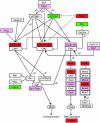Global gene expression analysis identifies molecular pathways distinguishing blastocyst dormancy and activation
- PMID: 15232000
- PMCID: PMC478571
- DOI: 10.1073/pnas.0402597101
Global gene expression analysis identifies molecular pathways distinguishing blastocyst dormancy and activation
Abstract
Delayed implantation (embryonic diapause) occurs when the embryo at the blastocyst stage achieves a state of suspended animation. During this period, blastocyst growth is very slow, with minimal or no cell division. Nearly 100 mammals in seven different orders undergo delayed implantation, but the underlying molecular mechanisms that direct this process remain largely unknown. In mice, ovariectomy before preimplantation ovarian estrogen secretion on day 4 of pregnancy initiates blastocyst dormancy, which normally lasts for 1-2 weeks by continued progesterone treatment, although blastocyst survival decreases with time. An estrogen injection rapidly activates blastocysts and initiates their implantation in the progesterone-primed uterus. Using this model, here we show that among approximately 20,000 genes examined, only 229 are differentially expressed between dormant and activated blastocysts. The major functional categories of altered genes include the cell cycle, cell signaling, and energy metabolic pathways, particularly highlighting the importance of heparin-binding epidermal growth factor-like signaling in blastocyst-uterine crosstalk in implantation. The results provide evidence that the two different physiological states of the blastocyst, dormancy and activation, are molecularly distinguishable in a global perspective and underscore the importance of specific molecular pathways in these processes. This study has identified candidate genes that provide a scope for in-depth analysis of their functions and an opportunity for examining their relevance to blastocyst dormancy and activation in numerous other species for which microarray analysis is not available or possible due to very limited availability of blastocysts.
Figures





Similar articles
-
Blastocyst's state of activity determines the "window" of implantation in the receptive mouse uterus.Proc Natl Acad Sci U S A. 1993 Nov 1;90(21):10159-62. doi: 10.1073/pnas.90.21.10159. Proc Natl Acad Sci U S A. 1993. PMID: 8234270 Free PMC article.
-
Dysregulation of EGF family of growth factors and COX-2 in the uterus during the preattachment and attachment reactions of the blastocyst with the luminal epithelium correlates with implantation failure in LIF-deficient mice.Mol Endocrinol. 2000 Aug;14(8):1147-61. doi: 10.1210/mend.14.8.0498. Mol Endocrinol. 2000. PMID: 10935540
-
Coordination of differential effects of primary estrogen and catecholestrogen on two distinct targets mediates embryo implantation in the mouse.Endocrinology. 1998 Dec;139(12):5235-46. doi: 10.1210/endo.139.12.6386. Endocrinology. 1998. PMID: 9832464
-
Intracellular signaling in the developing blastocyst as a consequence of the maternal-embryonic dialogue.Semin Reprod Med. 2000;18(3):273-87. doi: 10.1055/s-2000-12565. Semin Reprod Med. 2000. PMID: 11299966 Review.
-
Molecular interactions at the maternal-embryonic interface during the early phase of implantation.Semin Reprod Med. 2000;18(3):237-53. doi: 10.1055/s-2000-12562. Semin Reprod Med. 2000. PMID: 11299963 Review.
Cited by
-
Sequential activation of uterine epithelial IGF1R by stromal IGF1 and embryonic IGF2 directs normal uterine preparation for embryo implantation.J Mol Cell Biol. 2021 Dec 6;13(9):646-661. doi: 10.1093/jmcb/mjab034. J Mol Cell Biol. 2021. PMID: 34097060 Free PMC article.
-
Identification and expression analysis of genes associated with bovine blastocyst formation.BMC Dev Biol. 2007 Jun 8;7:64. doi: 10.1186/1471-213X-7-64. BMC Dev Biol. 2007. PMID: 17559642 Free PMC article.
-
Molecular Regulation of Paused Pluripotency in Early Mammalian Embryos and Stem Cells.Front Cell Dev Biol. 2021 Jul 27;9:708318. doi: 10.3389/fcell.2021.708318. eCollection 2021. Front Cell Dev Biol. 2021. PMID: 34386497 Free PMC article. Review.
-
Oxytocin induces embryonic diapause.Sci Adv. 2025 Mar 7;11(10):eadt1763. doi: 10.1126/sciadv.adt1763. Epub 2025 Mar 5. Sci Adv. 2025. PMID: 40043121 Free PMC article.
-
HB-EGF: a unique mediator of embryo-uterine interactions during implantation.Exp Cell Res. 2009 Feb 15;315(4):619-26. doi: 10.1016/j.yexcr.2008.07.025. Epub 2008 Aug 3. Exp Cell Res. 2009. PMID: 18708050 Free PMC article. Review.
References
-
- Dey, S. K., Lim, H., Das, S. K., Reese, J., Paria, B. C., Daikoku, T. & Wang, H. (2004) Endocr. Rev. 25, 341–373. - PubMed
-
- Paria, B. C., Reese, J., Das, S. K. & Dey, S. K. (2002) Science 296, 2185–2188. - PubMed
-
- Yoshinaga, K. & Adams, C. E. (1966) J. Reprod. Fertil. 12, 593–595. - PubMed
-
- McLaren, A. (1968) J. Endocrinol. 42, 453–463. - PubMed
Publication types
MeSH terms
Substances
Grants and funding
LinkOut - more resources
Full Text Sources
Other Literature Sources
Molecular Biology Databases

